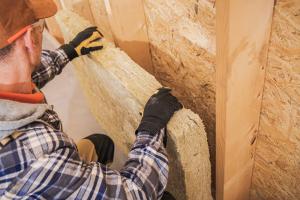The Importance of Proper Insulation in Homes and Commercial Buildings
A structure can have the finest design and finish, but without the right insulation, it will never perform at its potential”
SLIDELL, LA, UNITED STATES, October 22, 2025 /EINPresswire.com/ -- In the world of construction, insulation often goes unnoticed—tucked behind walls, ceilings, and floors. Yet, it plays a central role in the comfort, efficiency, and longevity of any structure. Proper insulation not only regulates indoor temperature but also influences moisture control, soundproofing, and overall structural health.— Elwin Ordoyne
According to Elwin Ordoyne, Vice President of E.C.O. Builders Inc. in Slidell, Louisiana, insulation should be considered one of the foundational systems in both residential and commercial buildings. “A structure can have the finest design and finish,” said Ordoyne, “but without the right insulation, it will never perform at its potential.”
The Purpose of Insulation
Insulation serves one simple but vital purpose: to resist heat flow. In summer, it keeps warm air out; in winter, it keeps warm air in. This balance maintains consistent indoor temperatures, reduces strain on heating and cooling systems, and creates a more stable environment year-round.
Every building material conducts heat at a different rate. Insulation slows that transfer, acting as a barrier that keeps conditioned air where it belongs. Without adequate insulation, even the most advanced HVAC systems must work harder, increasing operational costs and energy consumption.
Beyond temperature control, insulation also provides acoustic and moisture benefits. Properly installed insulation dampens sound transmission between rooms or from outside sources. It also helps prevent condensation buildup—one of the leading contributors to mold growth and structural damage in humid climates.
Climate and Regional Considerations
In regions such as southeast Louisiana, temperature swings, high humidity, and storm-prone conditions present unique challenges. Insulation must balance thermal resistance with moisture protection. The Gulf Coast climate creates conditions where air infiltration, humidity control, and vapor barriers must work in harmony.
Traditional batt insulation, for example, may not provide adequate vapor resistance in coastal environments. Closed-cell spray foam, reflective barriers, or rigid foam boards are often better suited for areas where moisture intrusion is a concern. The correct selection depends on building type, location, and purpose.
Commercial buildings—such as warehouses, offices, and retail spaces—require specialized insulation systems that accommodate larger volumes of air and varying usage patterns. In contrast, residential homes benefit from multi-layered insulation that accounts for attics, crawl spaces, and wall cavities.
The Cost of Poor Insulation
Poor insulation has consequences that go far beyond higher energy bills. When heat or humidity enters through gaps, the structure experiences constant expansion and contraction. Over time, this cycle weakens seals, warps materials, and accelerates wear on mechanical systems.
Condensation caused by improper insulation or ventilation can lead to water damage inside walls. Once moisture becomes trapped, it creates conditions for mold growth—a problem that can be costly to remediate and harmful to indoor air quality.
In commercial buildings, these inefficiencies compound quickly. Air leakage in large facilities drives up energy consumption and can affect the performance of refrigeration, production, or climate-sensitive storage areas. In residential settings, it impacts comfort and durability—causing rooms to feel drafty, uneven, or perpetually damp.
The Role of Air Sealing
Insulation alone cannot create an efficient building envelope. Air sealing is equally important. Tiny openings around windows, doors, vents, and electrical outlets allow air to pass freely, undermining the insulation’s performance.
When properly sealed, a building envelope maintains consistent air pressure and prevents conditioned air from escaping. This coordination between air sealing and insulation ensures long-term efficiency and stability.
Professional installers measure insulation effectiveness using the “R-value,” a rating that indicates resistance to heat flow. Higher R-values represent stronger thermal resistance, but the effectiveness always depends on installation quality. Even high-performance materials underperform when improperly fitted, compressed, or exposed to moisture.
Insulation and Environmental Impact
Energy efficiency isn’t just an economic concern—it’s also an environmental one. Proper insulation reduces the energy demand required to heat and cool a structure. This translates to lower carbon emissions and less strain on power grids during peak usage.
In commercial development, energy-efficient insulation contributes to compliance with building standards and sustainability certifications. Residentially, it helps homeowners reduce waste and maintain consistent comfort levels without excessive reliance on mechanical systems.
Some modern insulation materials are produced from recycled or renewable resources, further supporting sustainability goals. The construction industry continues to evolve toward greener solutions, and insulation remains one of the most cost-effective ways to reduce environmental impact.
The Importance of Professional Evaluation
Determining the right insulation type and amount depends on multiple factors—climate zone, building design, ventilation, and existing materials. Professional evaluation ensures that insulation is both sufficient and properly installed.
For new construction, this involves selecting materials that align with the design’s intended energy performance. For older structures, evaluation may include identifying areas where insulation has settled, deteriorated, or become compromised by moisture.
Thermal imaging tools can pinpoint cold or hot spots, showing exactly where improvements are needed. Replacing or supplementing insulation in these areas often yields significant improvements in comfort and efficiency.
Long-Term Structural Benefits
A well-insulated building doesn’t just save on energy costs—it preserves structural integrity. When indoor temperatures remain stable, building materials experience less stress from expansion and contraction. Over time, this reduces cracking, warping, and other forms of deterioration.
In Louisiana’s humid environment, moisture management is equally critical. The right combination of insulation and vapor control prevents condensation from forming inside walls, protecting against rot and corrosion.
For commercial facilities that house sensitive equipment, insulation also contributes to consistent internal temperatures, protecting electronics, inventory, and machinery from temperature-related damage.
Conclusion
Proper insulation is an investment in performance, safety, and durability. Whether in residential or commercial construction, it supports comfort, reduces energy waste, and extends the lifespan of the building itself.
Ignoring insulation—or treating it as an afterthought—creates long-term issues that are far more expensive to correct later. The right material, installed correctly, forms the unseen backbone of every efficient, resilient structure.
As construction methods evolve, insulation continues to stand as one of the most impactful elements of modern building science. Its effectiveness lies not in its visibility but in its ability to maintain balance—between temperature, moisture, and longevity—day after day, year after year.
Morgan Thomas
Rhino Digital, LLC
+1 504-875-5036
email us here
Visit us on social media:
Facebook
Legal Disclaimer:
EIN Presswire provides this news content "as is" without warranty of any kind. We do not accept any responsibility or liability for the accuracy, content, images, videos, licenses, completeness, legality, or reliability of the information contained in this article. If you have any complaints or copyright issues related to this article, kindly contact the author above.

